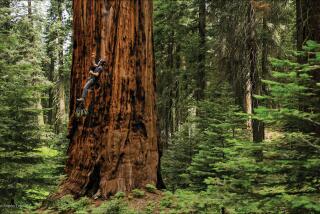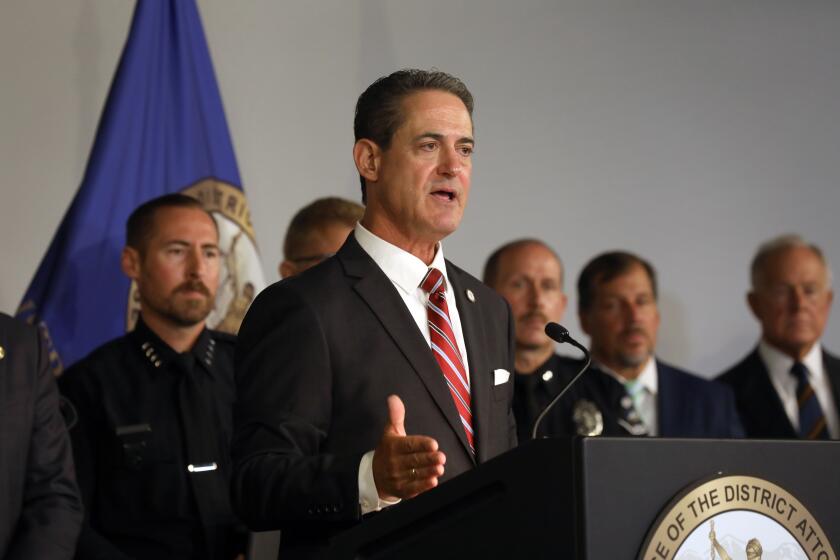Bush Pledges to Create Monterey Sanctuary : Environment: President’s proposal would permanently protect one-quarter of the state’s coastline from offshore drilling.
In a move heralded by environmentalists, President Bush on Thursday pledged to create an ocean sanctuary that virtually guarantees one-quarter of California’s coastline permanent protection from offshore oil and gas drilling.
The Monterey Bay National Marine Sanctuary, which will encompass an area bigger than the state of Connecticut, stretches from San Francisco Bay south to San Simeon Creek in San Luis Obispo County.
While Bush was widely expected to endorse the sanctuary, its precise boundaries and the controversial issue of a permanent drilling ban remained in question until Thursday.
“This is a historic day for California,” said Dan Haifley of Save Our Shores, a Santa Cruz-based group that has fought for coastal protection. “Barring a disaster or an act of God, the Central California coast will now forever be safe and free of the perennial fight over oil drilling.”
Once it is formally designated after a public comment period, the sanctuary will become the 11th and largest protected marine zone in the nation and the fourth in California. The others in this state are the Channel Islands, the Gulf of the Farallones, near San Francisco, and Cordell Bank, off the Sonoma County coast.
The Monterey Bay sanctuary is inhabited by a wide array of threatened or endangered species--including sea otters, a variety of whales, porpoises and sea birds--and is home to some of the country’s largest kelp forests, which provide shelter and nourishment to countless other marine creatures.
It also is geologically distinct, containing North America’s largest underwater canyon--a cleft in the ocean floor that plunges deeper than the Grand Canyon. Containing tide pools, rocky cliffs, sandy beaches and quiet coves, the newly protected area is considered the Yosemite of the national marine sanctuary system by experts.
Unlike the regulations governing national parks, those protecting sanctuaries allow for numerous commercial purposes, such as fishing. The chief purposes of sanctuary designation is to protect and enhance marine species, encourage public education and strengthen research.
Creation of the Monterey Bay sanctuary was required under a 1988 bill by Rep. Leon Panetta (D-Monterey). The bill set a 1989 deadline for its designation, but disputes over gas and oil drilling and opposition from the Interior Department slowed the process.
On Thursday, Panetta chastised the Administration for the delay but called the step “a tremendous victory” and praised Bush for selecting the most expansive of seven alternative sanctuary boundaries.
The sanctuary will be managed by the National Oceanic and Atmospheric Administration. Bush’s budget earmarks $510,600 for the sanctuary’s first year of operation.
Thursday’s announcement comes on the heels of the Earth Summit in Rio de Janeiro, which concluded on Sunday and left Bush vulnerable to criticism that he has reneged on his promise to be the “environmental President.”
Haifley said that while he and other conservationists view Thursday’s development as a strategic campaign move by Bush, they welcome it nonetheless.
“The President is attempting to make up for lost time and build bridges to the environmental community,” Haifley said. “If that’s what it takes to get the sanctuary, so be it.”
Environmentalists said they remain opposed, however, to several elements of the sanctuary plan. Specifically, they plan to fight a proposed 70-square-mile “donut hole” carved out of the sanctuary around a sewage outfall used by San Francisco.
Under the Administration’s plan, San Francisco will be allowed to discharge raw or partially treated sewage into the “donut hole” at times of excessive rain or flooding.
“While we don’t want to rain on the President’s announcement, we remain extremely concerned about threats to water quality” posed by the donut hole exemption and other aspects of the plan, said Jack Sobel, habitat conservation director for the Center for Marine Conservation in Washington.
More to Read
Sign up for Essential California
The most important California stories and recommendations in your inbox every morning.
You may occasionally receive promotional content from the Los Angeles Times.










